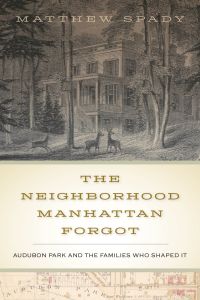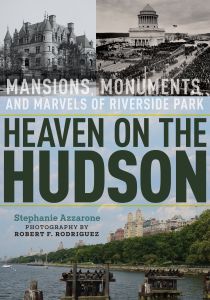Save 25% plus free shipping during our Winter Sale! Use promo code JOY2025. Expires 1/5/26.
Hamilton Heights and Sugar Hill
Alexander Hamilton’s Old Harlem Neighborhood Through the Centuries

This book can be opened with

Explores four centuries of colonization, land divisions, and urban development around this historic landmark neighborhood in West Harlem
It was the neighborhood where Alexander Hamilton built his country home, George Gershwin wrote his first hit, a young Norman Rockwell discovered he liked to draw, and Ralph Ellison wrote Invisible Man. Through words and pictures, Hamilton Heights and Sugar Hill traces the transition of this picturesque section of Harlem from lush farmland in the early 1600s to its modern-day growth as a unique Manhattan neighborhood highlighted by stunning architecture, Harlem Renaissance gatherings, and the famous residents who called it home.
Stretching from approximately 135th Street and Edgecombe Avenue to around 165th, all the way to the Hudson River, this small section in the Heights of West Harlem is home to so many significant events, so many extraordinary people, and so much of New York’s most stunning architecture, it’s hard to believe one place could contain all that majesty. Author Davida Siwisa James brings to compelling literary life the unique residents and dwelling places of this Harlem neighborhood that stands at the heart of the country’s founding. Here she uncovers the long-lost history of the transitions to Hamilton Grange in the aftermath of Alexander Hamilton’s death and the building boom from about 1885 to 1930 that made it one of Manhattan’s most historic and architecturally desirable neighborhoods, now and a century ago. The book also shares the story of the LaGuardia High School of Music & Art, one of the fi rst in the nation to focus on arts and music. The author chronicles the history of the James A. Bailey House, as well as the Morris-Jumel Mansion, Manhattan’s oldest surviving residence and famously known as George Washington’s headquarters at the start of the American Revolution.
By telling the history of its vibrant people and the beautiful architecture of this lovely, well-maintained historic landmark neighborhood, James also dispels the misconception that Harlem was primarily a ghetto wasteland. The book also touches upon the Great Migration of Blacks leaving the South who landed in Harlem, helping it become the mecca for African Americans, including such Harlem Renaissance artists and luminaries as Thurgood Marshall, Count Basie, Duke Ellington, Mary Lou Williams, Paul Robeson, Regina Anderson Andrews, and W. E. B. Du Bois.
Over the years, several books and projects have attempted to capture the essence of Hamilton Heights and Sugar Hill, and thankfully, with Davida Siwisa James, the legendary community has its griot. She brings a fresh veneer, a lively descriptive narrative to this timeless section of Harlem. To be sure, the dramatic moments of the past are invoked and then lavishly alloyed with the neighborhood’s current vibrancy.—HERB BOYD, Adjunct Professor, City College of New York author of Baldwin’s Harlem: A Biography of James Baldwin
Yes, her book is New York City history, but Davida Siwisa James’s exploration of northern Manhattan across the centuries also reveals the writer/artist in her. Strings of sentences sing so poetically. Old Hamiltonian New York and twentieth-century Harlem come alive with the stories in each chapter. Davida’s multiple identities shine through the book: self-made historian, poet, and non-fiction writer. Peace be with you, Davida. We lovers of New York City thank you so much.—RON HOWELL, Associate Professor of Journalism, Brooklyn College author of Boss of Black Brooklyn: The Life and Times of Bertram L. Baker
Hamilton Heights and Sugar Hill traces the transformation of New York’s West Harlem community from the ancestral hunting grounds of the Lenape Indians into the cultural mecca of Black America. Davida Siwisa James narrates with pictures of one of America’s most prolific neighborhoods. Hamilton Heights and Sugar Hill produced American icons like the writer James Weldon Johnson, the scholar George Edmund Haynes, the boxing champ Joe Louis, and the twentieth-century composer George Gershwin. But beyond that, this book makes an important contribution by showing how one small American neighborhood impacted New York’s culture, politics, and arts.—DR. BRUCE D. HAYNES, Professor of Sociology, University of California, Davis co-author of Down the Up Staircase: Three Generations of a Harlem Family
James describes the social connections between Harlem residents while supplying readers with context for each person she discusses, expertly capturing a sense of life in Harlem. VERDICT A fascinating record of the history and culture of influential neighborhoods in Harlem.—Library Journal
" . . . A sweeping account of the buildings, businesses, and streets that have been affected by modern-day gentrification, and looks at how this has changed Sugar Hill and Hamilton Heights--and Harlem as a whole. James offers an encyclopedic accounting of two of Harlem's historic neighborhoods . . .—Karen Juanita Carillo, New Amsterdam News
Hamilton Heights and Sugar Hill are changing, along with Harlem, but there is great value in knowing the past to better navigate the present. Davida Siwisa James’s probing, lyrical and insightful book helps us do both.—Journal of Urban Affairs
As someone who lived in Hamilton Heights for over twenty‐five years, Hamilton Heights and Sugar Hill introduced me to many aspects of its early history that I did not know, as well as provided me with a much better understanding of the people and places that made the neighborhoods of Hamilton Heights and Sugar Hill the vibrant communities that they remain today—Kevin McGruder, The Metropole: The Official Blog of the Urban History Association
Author Website Twitter
Author’s Historical Note | ix
Dyckman and Hamilton Maps | xi
Note on Spelling | xiii
Preface | xv
The Neighborhood | xxi
1. Dutch Beginnings and Native Americans | 1
2. The Making of Harlem Heights | 9
3. Harlem Land Grants, Mount Morris, and a Revolution | 22
4. Harlem Grange and the Duel | 38
5. The Jumels, the Street Grid, and Audubon | 55
6. The Bailey Mansion, St. Luke’s, and a Building Boom | 76
7. The Great Migration and the Morris Museum | 100
8. The Hamilton Museum and the Hamilton Theatre | 124
9. The Harlem Renaissance | 139
10. The Heights Identity and the Black Mecca | 170
11. Jazz Clubs, The Numbers, and Firsts | 193
12. The Advent of the Sixties, Generational Changes, and the Arts | 212
13. A Neighborhood’s Changing Face | 236
14. Parlor Jazz and the Great Renovation | 253
15. Changing Demographics and a Revived Hamilton Heights | 279
16. Bailey House, Jazz, and the Renaissance Remix | 302
17. Where It Leads | 336
Afterword | 345
Addendum A: Excerpted Harlem Ordinances and Land Patents | 349
Addendum B: Photos Past and Present | 353
Acknowledgments | 355
Notes | 359
Selected Bibliography | 375
Index | 383






